Climate change is putting pressure on communities to rethink design and operations, particularly with regard to environmental disasters. The negative impact of climate crisis on communities of color emphasizes the need for climate justice to minimize the devastating impact on these communities. Two terms are often used in conjunction with disproportionate environmental impact: Environmental Racism, and Environmental Justice. Environmental Racism is the disproportionate impact of climate change on people of color and those living in poverty. Environmental Justice is the response to address these disparities. This paper will focus on the impact of climate change on ethnic populations, discuss current trends in the United States Environmental Justice policy, and discuss the role of the mediator to help bridge the gap in conflicts that arise from the process. Ultimately, climate change will impact everyone. However, its initial impact is disproportionately targeting African American, Hispanic, and poor communities. This disproportionate impact is due to historical institutionalized practices such as redlining and other practices that have denied minorities access to resources. This has also decreased resilience within these communities to deal with the results of environmental disasters. Hurricane Katrina, for example, and its impact on communities in the south is an example of the disproportionate effects of climate disasters on communities of color. Additionally, evidence suggests that fragility is increasing in the USA as environmental disasters increase, particularly in less economically sound states. There are also rising concerns that this fragility may increase the potential for violent conflicts to arise. The more recent consequences of COVID19, its negative impact on communities of color, and an increase in violent incidents even directed towards religious institutions may signal that rising tensions may be an indirect result of the climate crisis. What then will be the role of the mediator, and how can the mediator contribute to providing greater resilience within the framework of Environmental Justice? This paper aims to address this question, and will include a discussion of potential steps mediators can take to help increase community resilience as well as some processes that can help reduce the ethnic tensions that are an indirect result of climate change.





